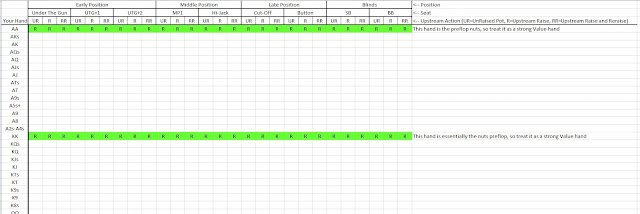Because they're so rare, we want to get the most bang for the buck when we are dealt one of these two monster hands. Unfortunately, for many beginners, this means they try to slow play, or "trap" when dealt AA or KK. They just can't stand the thought of raising preflop and then having everyone else fold, taking down just a small pot. They've waited hours for Aces, and they want to get paid off. So they limp or min-raise or overcall....and then they lose.... and then they complain that their big pocket pairs never hold up. And when they do manage to win via slow playing, they often only win only a small pot. Fancy play syndrome, or FPS, dooms them to winning small and/or losing big.
As I've mentioned before on this blog a number of times (including recently here), we want to build value when we have a Value hand. Before the flop, there is simply no better hand than Aces, so by definition it's a Value hand. In fact, it's the preflop nuts. Why on earth would you not want to bet and raise when you're holding the current nuts?
Kings are a similar story. The only hand that beats you preflop is Aces, and our opponents only get dealt Aces once every 221 hands. At a nine-handed table, this means that if you get dealt Kings UTG, there is only a 3.5% that one of the remaining eight players left to act has Aces. And if you do run into rockets against your 'boys, and all the money goes in, you still have about a one in five chance of cracking the better hand. In other words, you should almost never be afraid of Aces when holding Kings in a cash game. I think it was Dan Harrington that once said, "I'm not smart enough to fold Kings preflop. Neither are you." Only if you have a sick read on your opponent and put him with dead certainty on Aces preflop should you consider folding to a 4bet all-in preflop when holding KK.
Okay, this is all just a long-winded way of saying that the two premium pair hands, Aces and Kings, are super-duper Value hands, and should be treated as such when talking about ABC cash game play. Raise, re-reraise, and re-re-raise preflop with these hands. If you can get all the money in preflop, do so.* Stack sizes, opp tendencies, your position, their position, upstream and downstream action, etc. essentially don't factor into how to play the hands preflop at the micro- and low-stakes tables.**
So, click on the picture, below, to see how I think you should play AA and KK at a nine-handed table.***
The ABC bottom line, not surprisingly, is to raise preflop no matter what happens upstream of you. This is clearly one of the simplest examples, but it also illustrates how we're going to build the rest of the starting hand chart, hand-by-hand. Stay tuned...
All-in for now...
-Bug
*All bets are off (no pun intended) if you don't get all the money in preflop and have to actually play a post-flop game with either of these hands. At that point, all kinds of things like player type and tendencies, board texture, stack sizes, and so on will factor into how you play the hand postflop.... ah, but this is true of any hand you see a flop with.
**As we get into mid-stakes and above, however, and our play morphs from L1 and L2 to solid L3-type play, we can start doing things like cold-calling to induce bluffs and so on. Our own image becomes incredibly important, and we can often get the opp to do our betting for us to build value in the pot preflop.
***A few words of explanation about using this chart (which, by the way, may not be the final format I use, but for now will serve as the data collection/display device for each hand and how to play it in an ABC manner). First, find your hand down the left side of the chart. Then find your position and seat along the top of the chart. Next find the upstream action that you're facing along the top; UR=Unraised Pot, R=Raised Pot, RR=ReRaised Pot. The cell in the middle of the table that intersects your hand and the upstream action you're facing is the action you should take. An "R" means you should raise (or bet, if the pot is unopened). "C" will mean call. And "F" is fold. There will be more to explain as we get into some of the more complex hands, but for now the chart is really this simple to use. And in this example, all the cells for AA and KK say to raise, regardless of the action you're facing.

No comments:
Post a Comment